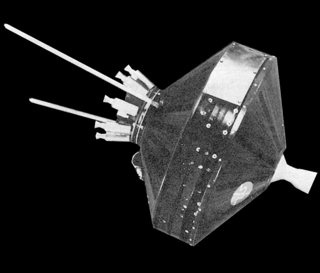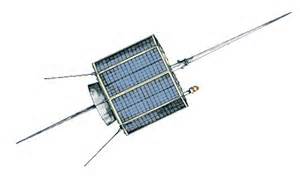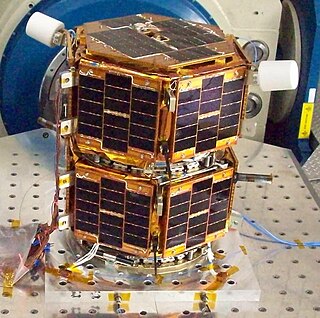Related Research Articles

Pioneer 0 was a failed United States space probe that was designed to go into orbit around the Moon, carrying a television camera, a micrometeorite detector and a magnetometer, as part of the first International Geophysical Year (IGY) science payload. It was designed and operated by the Air Force Ballistic Missile Division as the first spacecraft in the Pioneer program and was the first attempted launch beyond Earth orbit by any country, but the rocket failed shortly after launch. The probe was intended to be called Pioneer, but the launch failure precluded that name.
AMSAT is a name for amateur radio satellite organizations worldwide, but in particular the Radio Amateur Satellite Corporation (AMSAT) with headquarters at Washington, D.C. AMSAT organizations design, build, arrange launches for, and then operate (command) satellites carrying amateur radio payloads, including the OSCAR series of satellites. Other informally affiliated national organizations exist, such as AMSAT Germany (AMSAT-DL) and AMSAT Japan (JAMSAT).
UoSAT-2, which is also known as UO-11 and OSCAR-11, is a British satellite orbiting in Low Earth Orbit. The satellite functions as an amateur radio transmitter and was built at the University of Surrey. It launched into orbit in March 1984 and remains orbital and active, though unstable with irregular periods of transmission. All of the Analog telemetry channels have failed, making telemetry from OSCAR 11 useless. The satellite was still heard transmitting telemetry in 2015, thirty years after launch.

AMSAT-OSCAR 51 or AO-51 is the in-orbit name designation of a now defunct LEO amateur radio satellite of the OSCAR series; formerly known as ECHO, built by AMSAT. It was launched on June 29, 2004 from Baikonur Cosmodrome, Kazakhstan on a Dnepr launch vehicle. It is in sun synchronous low Earth orbit.
HAMSAT also known as HAMSAT INDIA, VU2SAT and VO-52 is a microsatellite weighing 42.5 kilograms (93.7 lb), providing amateur radio satellite communications services for Indian and international amateur radio operators. This satellite carries the in-orbit designation of VO-52, and is an OSCAR series satellite.

FalconSAT is the United States Air Force Academy's (USAFA) small satellite engineering program. Satellites are designed, built, tested, and operated by Academy cadets. The project is administered by the USAFA Space Systems Research Center under the direction of the Department of Astronautics. Most of the cadets who work on the project are pursuing a bachelor of science degree in astronautical engineering, although students from other disciplines join the project.

MidSTAR-1 is an artificial satellite produced by the United States Naval Academy Small Satellite Program. It was sponsored by the United States Department of Defense (DoD) Space Test Program (STP), and was launched on March 9, 2007 at 03:10 UTC, aboard an Atlas V expendable launch vehicle from Cape Canaveral Air Force Station. MidSTAR-1 flew along with FalconSat 3, STPSat 1, and CFESat as secondary payloads; the primary payload was Orbital Express.

AMSAT-OSCAR 7, or AO-7, is the second Phase 2 amateur radio satellite constructed by the Radio Amateur Satellite Corporation or AMSAT. It was launched into Low Earth Orbit on November 15, 1974 and remained operational until a battery failure in 1981. Then after 21 years of apparent silence, the satellite was heard again on June 21, 2002 – 27 years after launch. At that time the public learned that the satellite had remained intermittently functional and was used surreptitiously for communication by the anticommunist opposition Fighting Solidarity during martial law in Poland.

Formation Autonomy Spacecraft with Thrust, Relnav, Attitude and Crosslink is a pair of nanosatellites developed and built by students at The University of Texas at Austin. The project is part of a program sponsored by the Air Force Research Laboratory (AFRL), whose goal is to lead the development of affordable space technology. The FASTRAC mission will specifically investigate technologies that facilitate the operation of multiple satellites in formation. These enabling technologies include relative navigation, cross-link communications, attitude determination, and thrust. Due to the high cost of lifting mass into orbit, there is a strong initiative to miniaturize the overall weight of spacecraft. The utilization of formations of satellites, in place of large single satellites, reduces the risk of single point failure and allows for the use of low-cost hardware.

Compass-1 is a German amateur CubeSat picosatellite, built and operated in the late 2000s by Aachen University of Applied Science. It was launched by the Indian Space Research Organisation, aboard a PSLV rocket as a secondary payload to the CartoSat-2A primary spacecraft on 28 April 2008. It was launched into a Geocentric orbit with an altitude of 597 km. Its primary mission is remote sensing; however, it also contains some technology demonstration experiments regarding the use of small satellites and GPS tracking.
The Intelsat VI series of satellites were the 8th generation of geostationary communications satellites for the Intelsat Corporation. Designed and built by Hughes Aircraft Company (HAC) in 1983-1991, there were five VI-series satellites built: 601, 602, 603, 604, and 605.
SSETI Express was the first spacecraft to be designed and built by European students and was launched by the European Space Agency. SSETI Express is a small spacecraft, similar in size and shape to a washing machine. On board the student-built spacecraft were three CubeSat picosatellites, extremely small satellites weighing around one kg each. These were deployed one hour and forty minutes after launch. Twenty-one university groups, working from locations spread across Europe and with very different cultural backgrounds, worked together via the internet to jointly create the satellite. The expected lifetime of the mission was planned to be 2 months. SSETI Express encountered an unusually fast mission development: less than 18 months from kick-off in January 2004 to flight-readiness.
AMSAT-OSCAR 16, also known as AO-16 and PACSAT, is the in-orbit name designation of an amateur radio satellite of the OSCAR series. It was built by AMSAT and was launched on 22 January 1990 from Kourou, French Guiana on an Ariane 4 launch vehicle. It is in sun synchronous low Earth orbit.
Sputnik 40, also known as Sputnik Jr, PS-2 and Radio Sputnik 17 (RS-17), was a Franco-Russian amateur radio satellite which was launched in 1997 to commemorate the fortieth anniversary of the launch of Sputnik 1, the world's first artificial satellite. A 4-kilogram (8.8 lb) one-third scale model of Sputnik 1, Sputnik 40 was deployed from the Mir space station on 3 November 1997. Built by students, the spacecraft was constructed at the Polytechnic Laboratory of Nalchik in Kabardino-Balkaria, whilst its transmitter was assembled by Jules Reydellet College in Réunion with technical support from AMSAT-France.
Australis-OSCAR 5 is an amateur radio satellite that was launched into Low Earth Orbit on 23 January 1970 by a Thor Delta launcher from Vandenberg Air Force Base, Lompoc, California. AO-5 was launched piggyback with TIROS-M (ITOS-1) weather satellite).

Dove-OSCAR 17 is a Brazilian educational and amateur radio satellite (BRAMSAT) (AMSAT-BRAZIL) launched on 22 January 1990.

Progress MS-09, identified by NASA as Progress 70P, was a Progress spaceflight operated by Roscosmos to resupply the International Space Station (ISS). This was the 161st flight of a Progress spacecraft.
Fox-1D, AO-92 or AMSAT OSCAR 92 is an American amateur radio satellite. Fox-1D is a 1U CubeSat developed and built by AMSAT-NA. Fox-1D carries a single-channel transponder for mode U/V in FM. Fox-1D has an L-band converter, which allows the FM transponder to be switched on an uplink in the 23 centimetres (9.1 in) band.
Fox-1A, AO-85 or AMSAT OSCAR 85 is an American amateur radio satellite. It is a 1U Cubesat, was built by the AMSAT-NA and carries a single-channel transponder for FM radio. The satellite has one rod antenna each for the 70 centimetres (28 in) and 2 metres bands. To enable a satellite launch under NASA's Educational Launch of Nanosatellites (ELaNa) program, the satellite continues to carry a Penn State University student experiment.
Fox-1E, AO-109, Evolution or AMSAT OSCAR 109 is an American amateur radio satellite. It is a 1U Cubesat, was built by the AMSAT-NA and carries a single-channel transponder for FM radio. Fox-1E is the fifth amateur radio satellite of the Fox series of AMSAT North America.
References
- ↑ "SpaceNews 27-Nov-00". Radio Amateur Satellite Corporation. 27 November 2000. Retrieved 11 December 2016.
